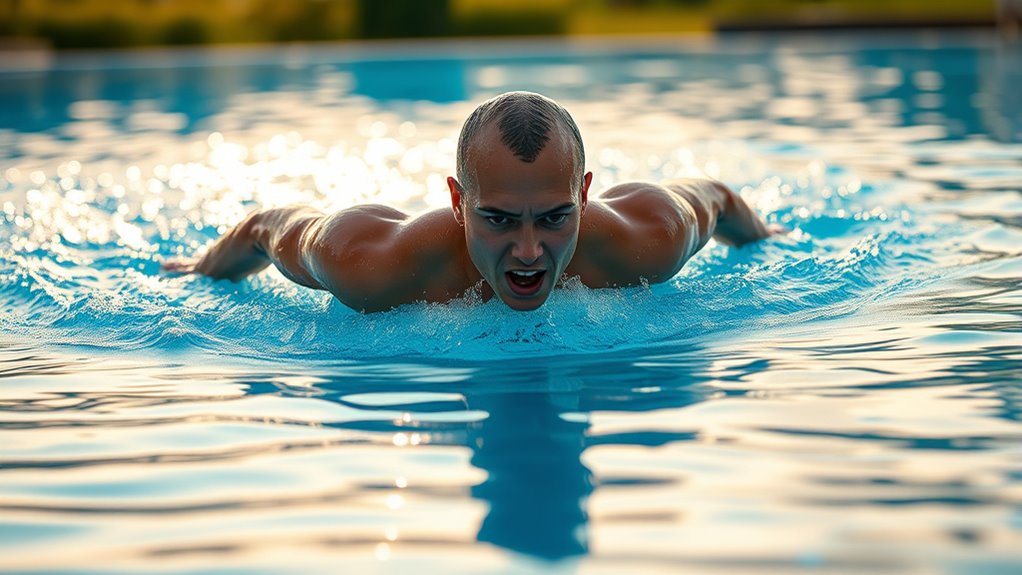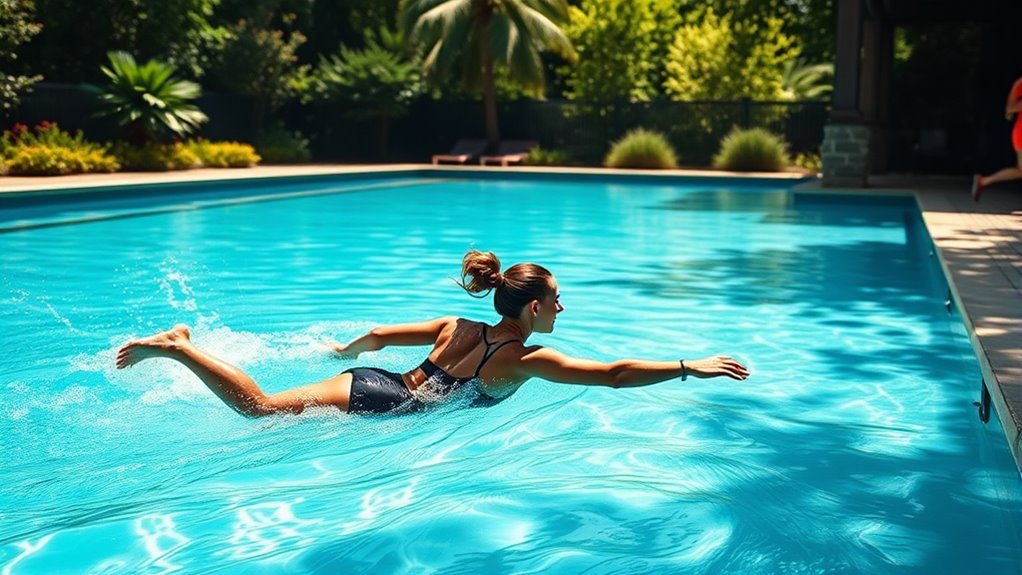Swimming burns more calories than running because water resistance works your muscles continuously, providing a full-body workout that targets more muscle groups. It’s also low-impact, reducing joint stress, which lets you exercise longer and more comfortably. Unlike running, swimming involves resistance that naturally increases effort, helping you burn fat faster. If you want to learn how swimming stacks up and the best ways to maximize your fat loss, keep exploring what makes it so effective.
Key Takeaways
- Swimming offers full-body engagement and water resistance, leading to higher calorie burn than running.
- It is low-impact, reducing joint stress, making it suitable for injury-prone or overweight individuals.
- Water resistance increases effort per movement, enhancing muscle activation and fat loss compared to running.
- Longer, sustained workouts are possible in water due to cooling effects, boosting overall calorie expenditure.
- Unlike running, swimming targets multiple muscle groups simultaneously, providing a more comprehensive fat-burning exercise.

Swimming is an excellent way to burn calories and shed excess fat because it engages multiple muscle groups simultaneously. One of the main reasons swimming is so effective for fat loss is the natural water resistance you encounter with every movement. Unlike running on a treadmill or pavement, water provides a gentle yet powerful resistance that forces your muscles to work harder. This resistance makes each stroke, kick, and pull more demanding, boosting your calorie burn without needing extra equipment or intense impact. When you swim, you’re not just moving through water—you’re fighting against it, which substantially increases the effort required and, consequently, the number of calories you burn. This heightened calorie burn means you can achieve your fat loss goals more efficiently, especially when combined with consistent swimming routines. Additionally, many local pools and facilities have specific hours that accommodate various schedules, making it easier to fit swimming into your routine.
Water resistance plays an essential role in turning swimming into a high-calorie-burning activity. Every stroke you make, whether freestyle, breaststroke, or butterfly, requires you to push against the water. This constant resistance engages your core, arms, legs, and back, creating a full-body workout that’s gentle on your joints. Because water is denser than air, your muscles work harder to propel yourself forward, leading to a higher calorie expenditure compared to some other low-impact activities. As a result, swimming can burn more calories per minute than many traditional forms of cardio, making it an excellent choice for fat loss. Plus, the resistance adapts to your effort, so as you get stronger, the challenge increases naturally, helping you build muscle while burning fat.
Compared to running, swimming offers a unique advantage in calorie burn due to its resistance properties. While running is an effective cardio workout, it primarily targets your lower body and can be tough on your joints, especially if you’re overweight or have injuries. Swimming, on the other hand, provides a low-impact alternative that still delivers a substantial calorie burn. Because it’s a full-body activity, you engage muscles that don’t get as much attention when running, leading to more calorie expenditure overall. Additionally, the cooling effect of water helps keep your body temperature regulated, allowing you to work out longer without feeling overheated or exhausted too quickly. This endurance aspect means you can sustain longer sessions, further increasing your fat-burning potential.
Frequently Asked Questions
How Does Swimming Affect Muscle Tone Compared to Running?
Swimming enhances muscle tone more effectively than running because it involves greater muscle engagement through resistance training. As you swim, your muscles work against water’s resistance, targeting multiple muscle groups simultaneously. This resistance training helps build and tone muscles, especially in your core, arms, and legs. Unlike running, which primarily focuses on leg muscles, swimming provides a full-body workout that improves muscle definition and strength more detailed.
Can Swimming Help Improve Joint Health More Than Running?
Yes, swimming can improve your joint health more than running. It promotes joint mobility by providing a low-impact workout that reduces stress on your cartilage and joints. The buoyancy support eases pressure, helping preserve cartilage and prevent wear and tear. This gentle, full-body exercise boosts circulation and flexibility, making it especially beneficial if you’re dealing with joint issues or looking to maintain healthy, pain-free joints over time.
What Are the Best Swimming Strokes for Fat Loss?
Think of your fat loss journey like a well-choreographed dance—each stroke counts. The best swimming strokes for fat loss are freestyle and butterfly because they engage large muscle groups, boosting calorie burn. Focus on proper swimming techniques and use the right swimming gear, like fins and kickboards, to maximize intensity. Incorporating these strokes into your routine can make your workout more effective, helping you shed fat faster and enjoy the process.
How Does Water Temperature Influence Calorie Burn During Swimming?
When water temperature is colder, your body burns more calories to maintain its core temperature, boosting calorie burning during swimming. If the water is warmer, you might burn fewer calories because your body doesn’t need to work as hard to stay warm. So, choosing colder water can enhance your calorie burn, making your swim more effective for fat loss. Just verify you’re comfortable and safe in the water temperature you select.
Is Swimming Suitable for People With Certain Injuries or Disabilities?
Swimming can be a gentle giant for your fitness journey, especially if you have injuries or disabilities. It’s often used in aquatic therapy, making it a disability-friendly exercise that minimizes impact and reduces pain. You can customize movements to suit your needs, building strength and flexibility safely. Always consult with a healthcare professional first, but swimming offers a supportive environment where you can stay active and improve your well-being.
Conclusion
If you’re looking to shed fat effectively, swimming might surprise you—burning up to 500 calories per hour, depending on intensity. It’s a low-impact workout that’s easy on your joints, making it ideal for all fitness levels. While running burns slightly more calories per hour, swimming offers a full-body workout that tones muscles while torching fat. So, whether you prefer water or pavement, both activities can help you reach your goals—just find what keeps you moving!










